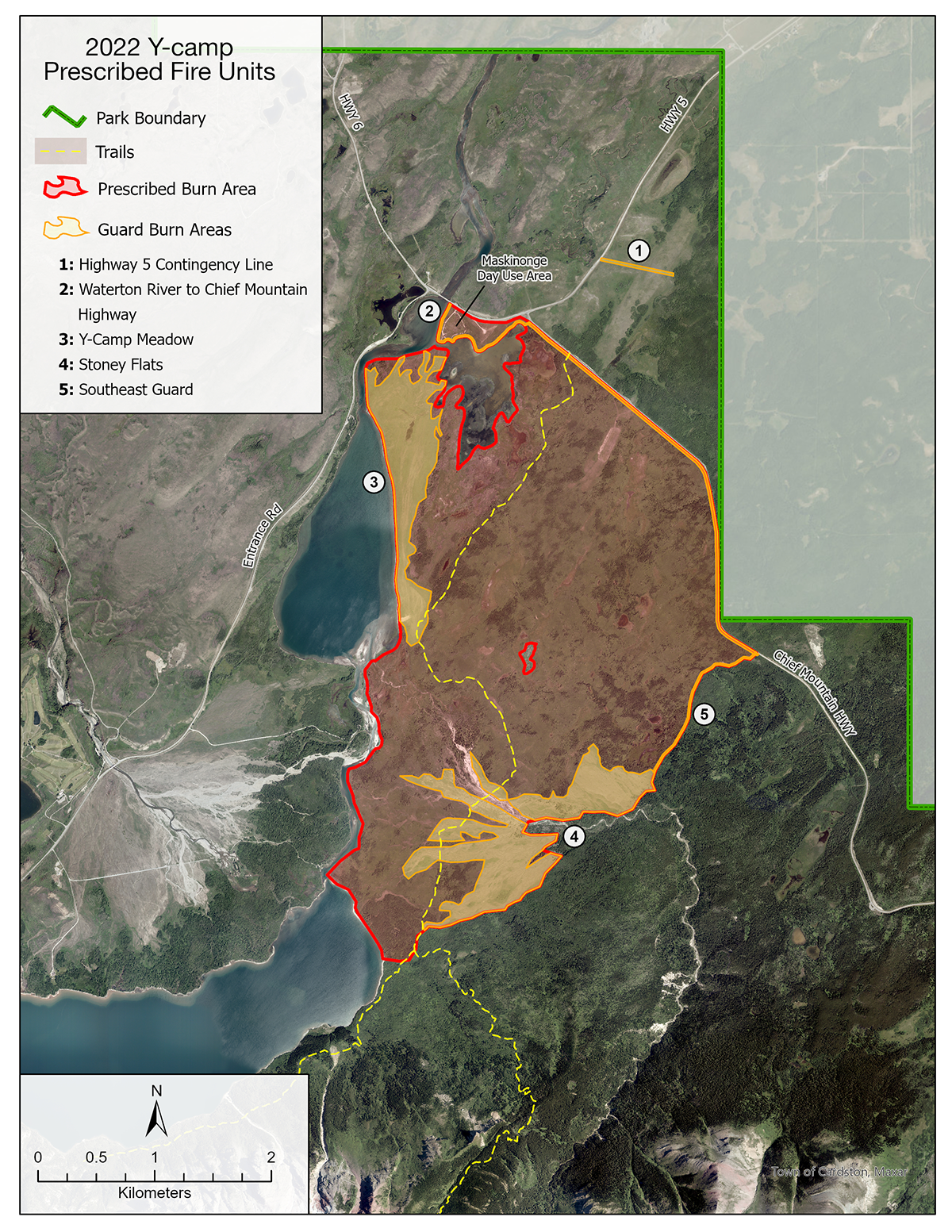Y-Camp prescribed fire in spring 2022 successful
Waterton Lakes National Park
On May 5, 2022, fire managers safely completed ignition operations of the Y-Camp prescribed fire in Waterton Lakes National Park. First, ground and aerial ignition teams expanded the fireguard along the Chief Mountain Highway. Larger sections of the prescribed fire area were then ignited using the same techniques. Crews returned fire to approximately 600 hectares of the 1,200-hectare prescribed fire zone. Precipitation in the evening, overnight, and over the following weekend suppressed fire activity. Crew members then extinguished hot spots, patrolled the area, and demobilized equipment.
Why this prescribed fire Is important
The objective of the Y-Camp prescribed fire is to restore native prairie by reducing aspen and evergreen tree expansion onto grasslands. Historic photographs show that fire suppression has allowed trees to encroach on park grasslands (Fescue Grasslands Ecoregion), with as much as 30% of grasslands lost over the last 100 years.
Safety is always the top priority for Parks Canada in all fire management operations. Prescribed fire plans are peer reviewed and identify specific weather conditions and resources necessary to ensure the safety of people and property. Parks Canada has nearly 40 years’ experience using fire to naturally restore ecological integrity in national parks.
Where is the Y-Camp prescribed fire?
The “Y-Camp” Prescribed Fire Unit is a 1,170-hectare area between Chief Mountain Highway and where Lower Waterton Lake meets the Dardanelles, and east along the Waterton River to Middle Waterton Lake. The prescribed fire includes two-stages: guard burning and preparation in the fall, winter and spring; and main unit ignition in the spring.
Y-Camp prescribed fire
The Y-Camp prescribed fire was previously ignited in 2015. Parks Canada has been successfully implementing prescribed fires in Waterton Lakes National Park since 1989.
Portions of the Y-Camp prescribed fire unit were burned by the Kenow Wildfire in 2017, but most of the area was unaffected. Parks Canada is returning fire to this landscape as the historical fire frequency for grasslands is 5 to 10 years. Fire kick-starts regeneration by providing ideal growing conditions. Many ecosystems have evolved with fire and depend on it for renewal.
What is a prescribed fire? Are they safe?
Prescribed fire is the intentional application of fire to a specific land area, planned and managed by fire specialists, to accomplish ecological and wildfire risk reduction objectives:
- Improve the health of ecosystems
- Reduce the risk of wildfire
Parks Canada fire management personnel are highly trained professionals, and prescribed fires are only conducted when the safety of people and property can be assured.
Each prescribed fire requires a peer reviewed plan and environmental impact assessment. Prescribed fire plans outline specific conditions in which the fire must be implemented. Conditions may include:
- Specific weather, including wind direction and speed, type and condition of vegetation, moisture levels, terrain, anticipated fire behavior and more
- Good atmospheric venting to minimize negative impacts of smoke
- Protection for ecological, infrastructure and cultural values
Boundaries of prescribed fires are determined using existing landscape features, such as waterbodies, and constructed fire guards (such as sprinkler line). Ground crews and helicopters may also be used to ensure prescribed fires remain within pre-defined boundaries.
Parks Canada strives to restore the historic fire regime within Canada’s national parks. Historically, Waterton Lakes National Park has evolved with fire on the landscape, started by lightning and Indigenous peoples.
Related links
- Date modified :
